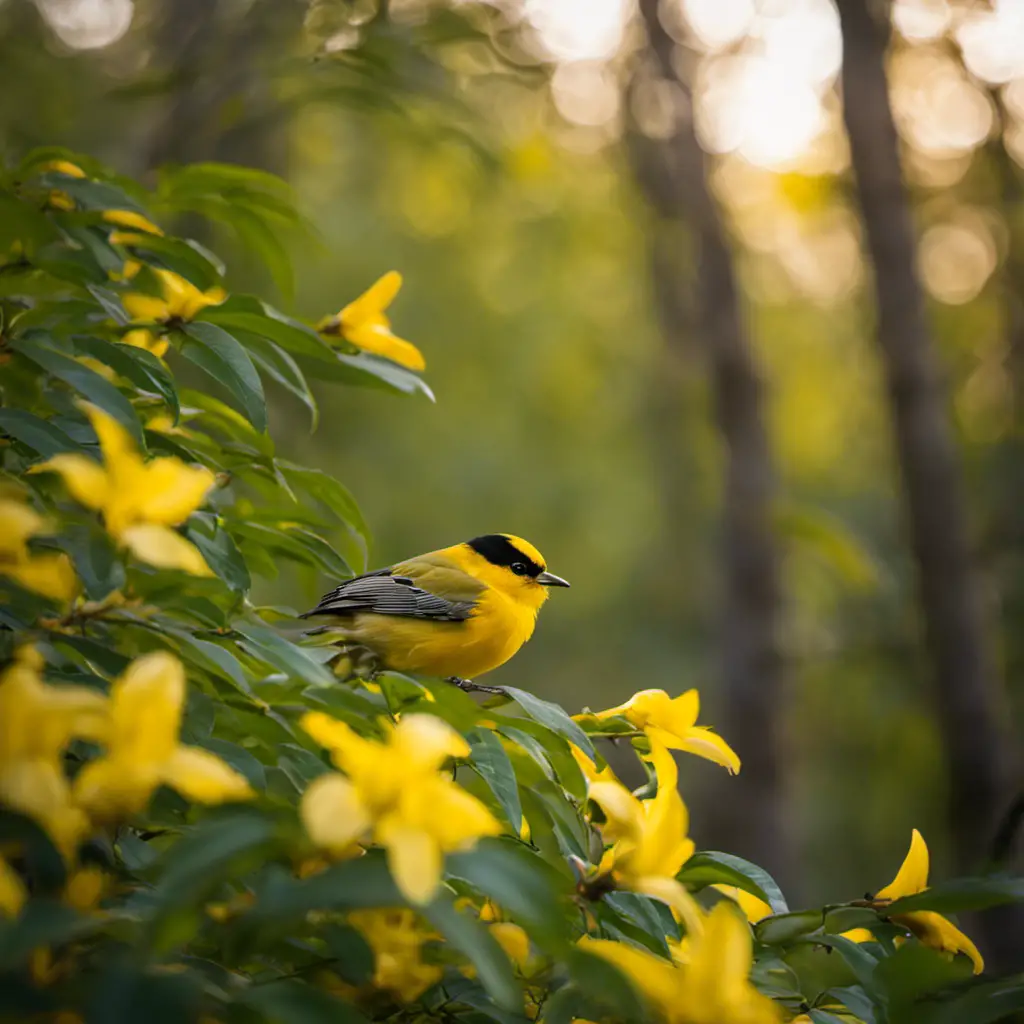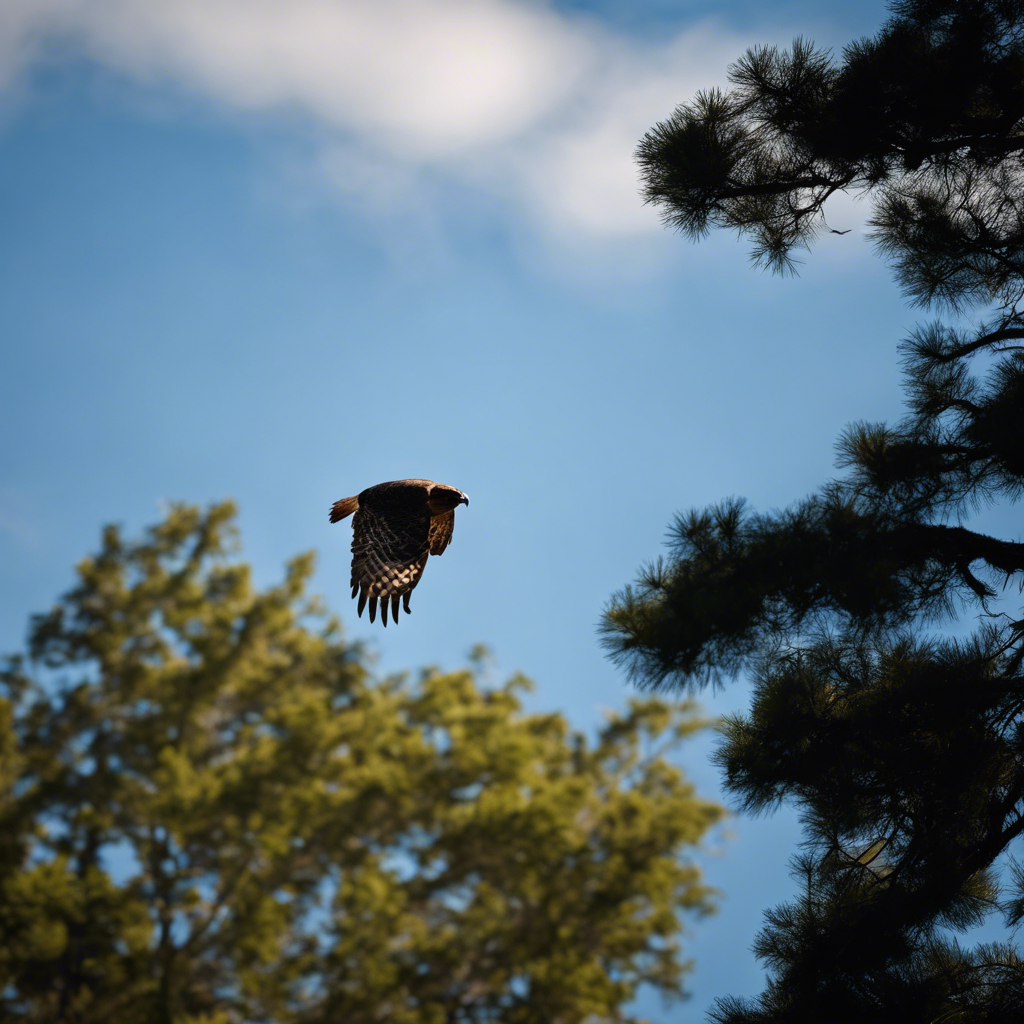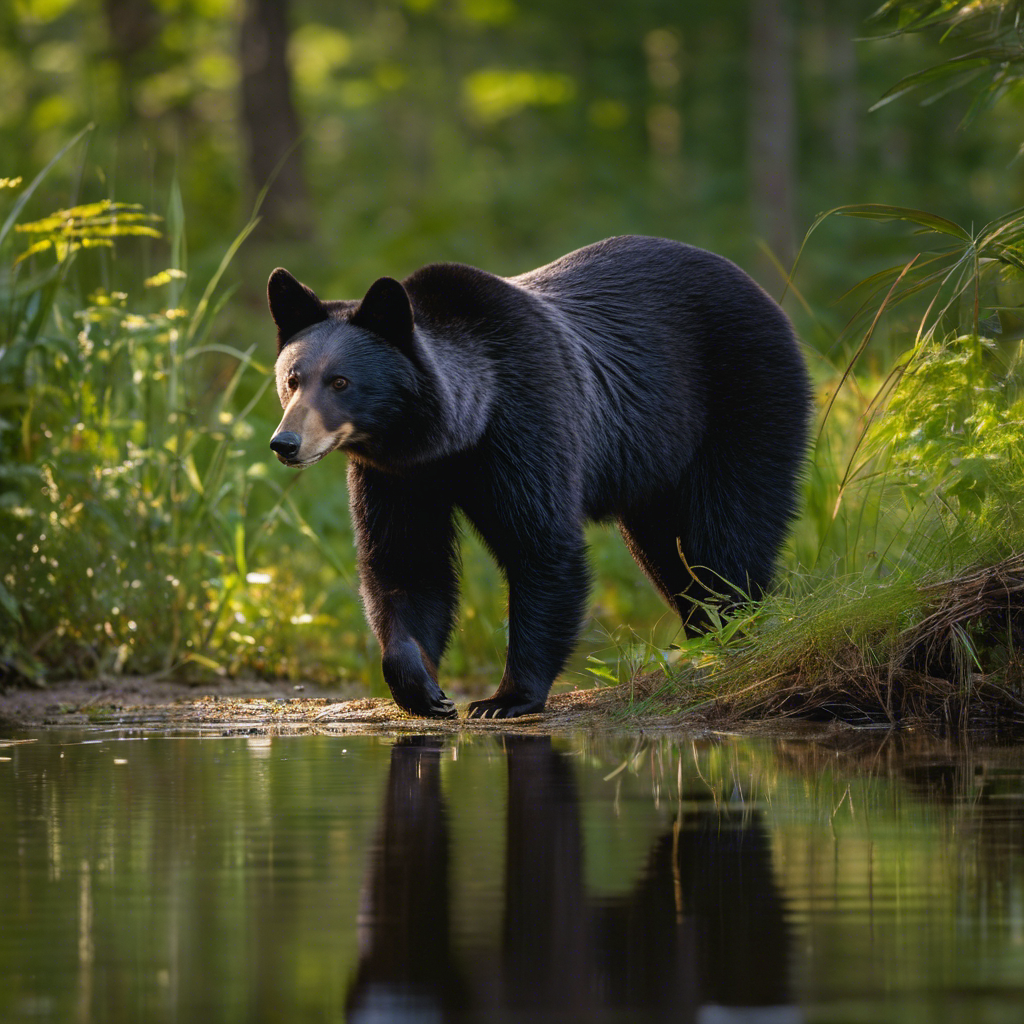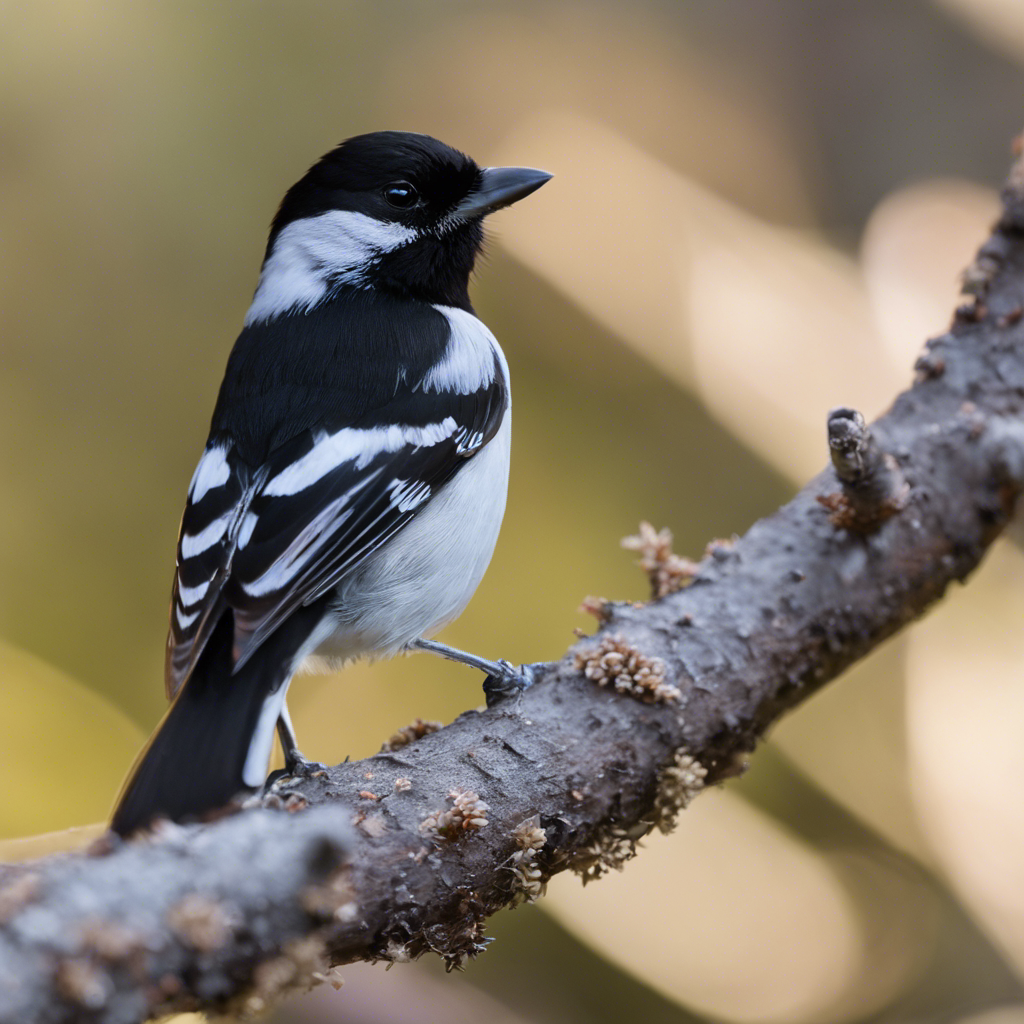If you’re in North Carolina and want to spot some vibrant yellow birds, you’re in luck! The state is home to a diverse array of these feathered beauties.
From the American Goldfinch to the Yellow Warbler, the Yellow-bellied Sapsucker to the Yellow-headed Blackbird, there’s no shortage of stunning species to marvel at.
In this article, we’ll delve into the fascinating world of these yellow birds, providing you with insights into their habitats, behaviors, and unique characteristics.
Get ready for a colorful avian adventure!
Key Takeaways
- Yellow birds, such as the American Goldfinch, Yellow Warbler, and Yellow-rumped Warbler, are commonly seen during migration patterns in North Carolina.
- These birds have distinctive yellow plumage and are highly adaptable, being found in various habitats across the state.
- Conservation efforts for yellow birds in North Carolina focus on protecting their habitats and ensuring an adequate food supply.
- Educating the public about the importance of preserving the natural environment for yellow birds is crucial for their conservation.
American Goldfinch
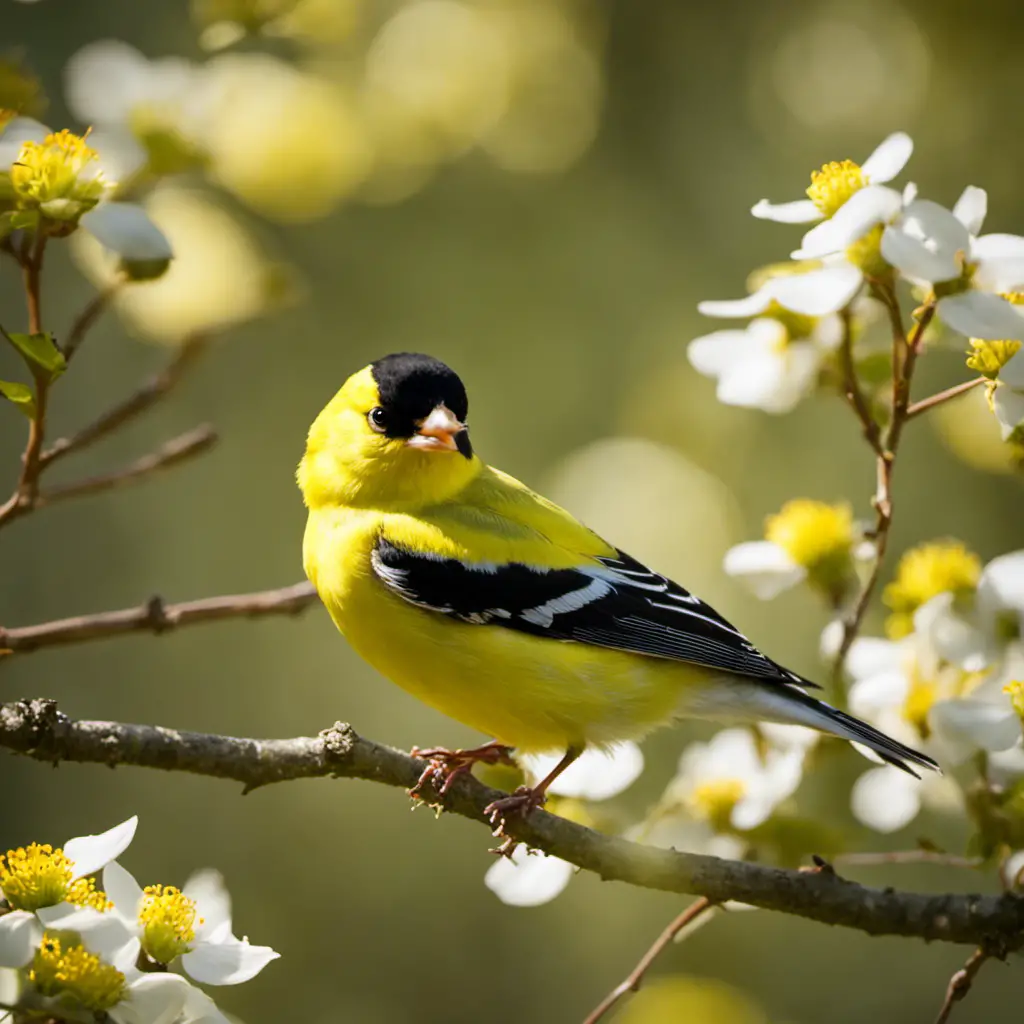
You should check out the beautiful flock of American Goldfinches in your backyard right now. These vibrant yellow birds are a common sight during their migration patterns.
American Goldfinches are known for their distinctive coloration, with bright yellow plumage and black wings. During the breeding season, the males develop a striking black cap on their heads.
These birds are highly adaptable and can be found in a variety of habitats, from open fields to gardens. Conservation efforts for the American Goldfinch focus on protecting their habitats and food sources, as well as educating the public about the importance of preserving their natural environment.
Yellow Warbler
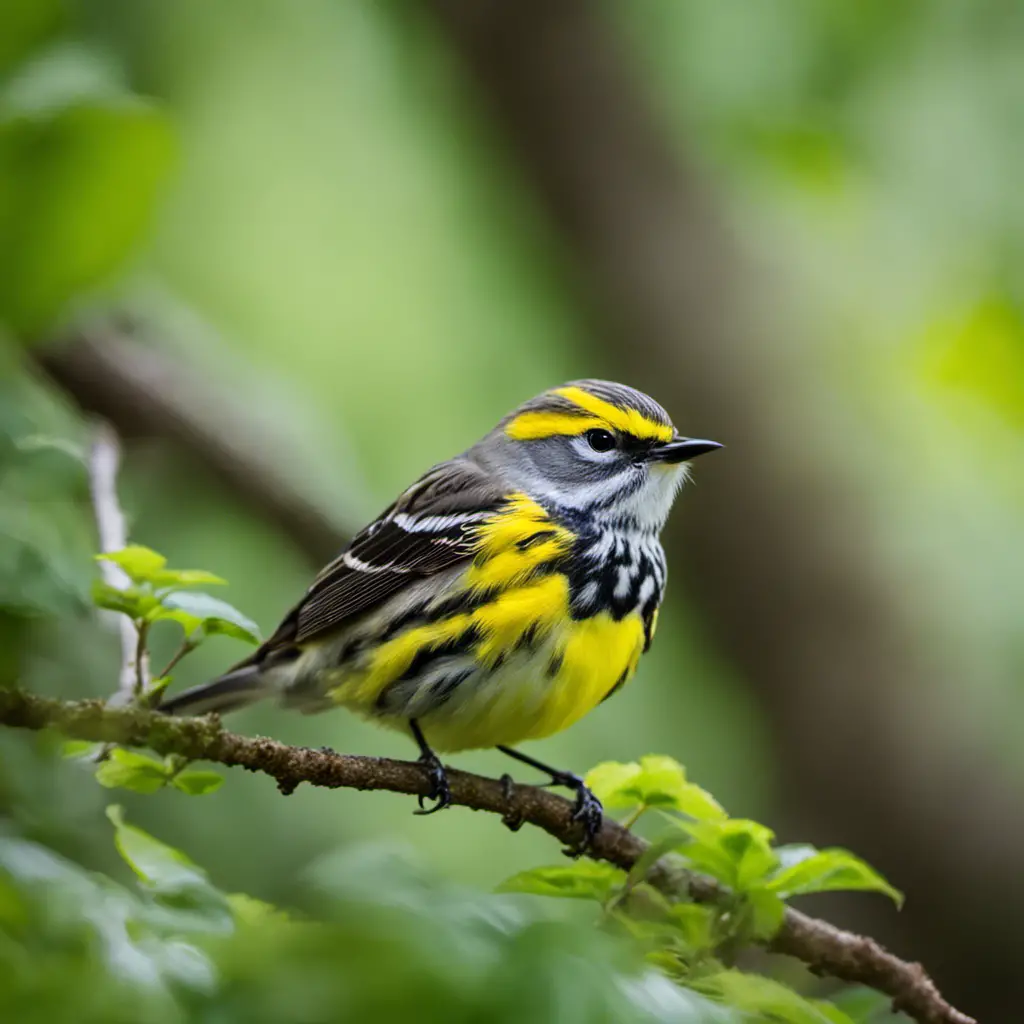
There is a yellow warbler singing its beautiful song in the tree next to you. This small, vibrant bird is a common sight in North America during the breeding season.
Here are some interesting facts about yellow warblers that will captivate your interest:
Yellow warbler migration patterns: These birds are known for their long-distance migration. They breed in North America during the summer and then fly thousands of miles to their wintering grounds in Central and South America.
Yellow warbler breeding habits: These birds are monogamous and form pair bonds during the breeding season. The female builds a cup-shaped nest using grass, bark, and spider silk, usually in a shrub or tree. She lays 3-5 eggs and both parents take turns incubating them.
Vocalizations: Yellow warblers have a distinctive song, a series of musical notes that sounds like ‘sweet, sweet, sweet, I’m so sweet!’ They use their song to attract mates and establish territory.
Habitat: Yellow warblers prefer wetland areas, such as marshes and swamps, but can also be found in gardens, parks, and forest edges. They’re often seen flitting among the branches of trees and shrubs.
Conservation status: While yellow warblers are currently considered a species of least concern, their populations have been declining in some areas due to habitat loss and fragmentation.
Yellow-rumped Warbler
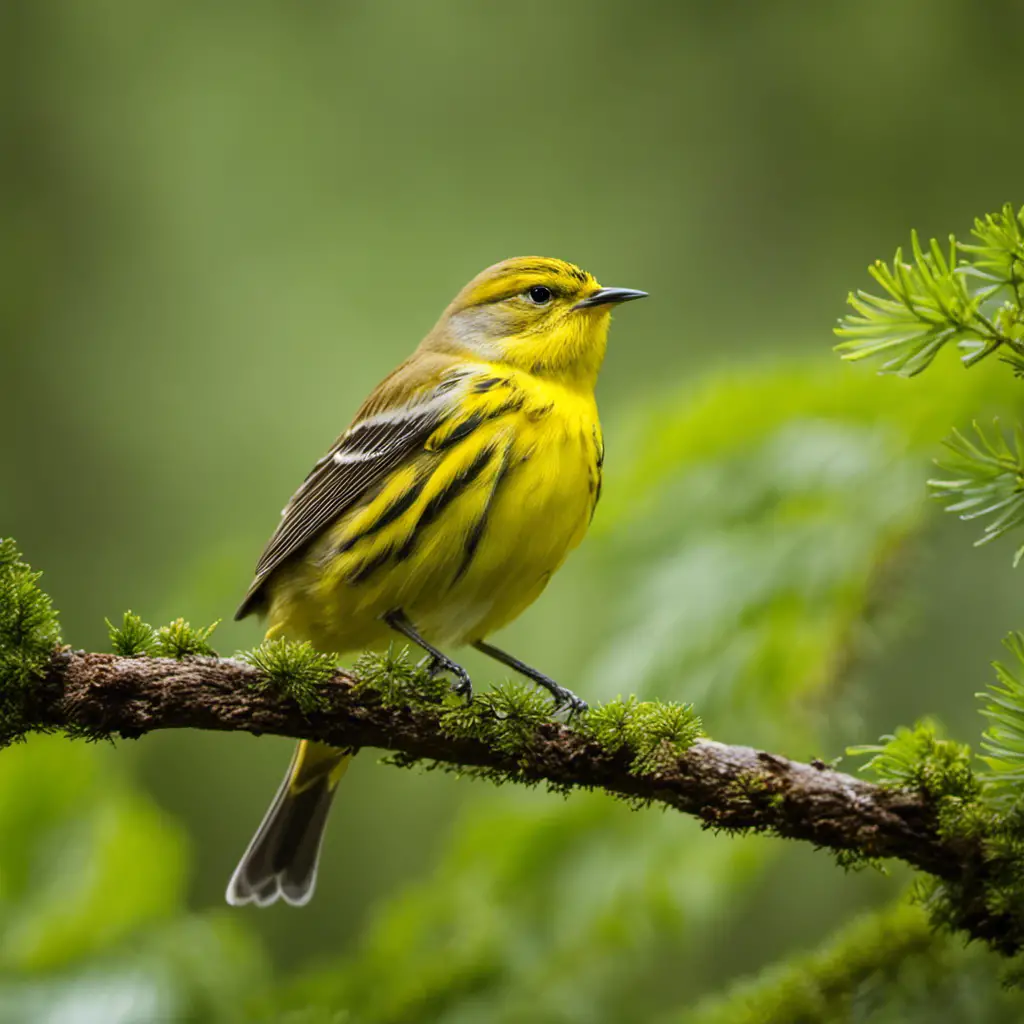
Have you seen the flock of yellow-rumped warblers that just arrived in the park? These beautiful birds are currently migrating and can be found in various habitats across North America.
The yellow-rumped warbler, scientifically known as Setophaga coronata, is known for its distinctive yellow rump and its ability to thrive in a wide range of environments. During their migration, these warblers travel long distances, from their breeding grounds in Canada and Alaska to their wintering grounds in the southern United States, Mexico, and Central America.
They prefer habitats such as coniferous and mixed forests, as well as open woodlands and shrubby areas. In these habitats, they can find ample food sources, including insects, berries, and seeds.
Common Yellowthroat
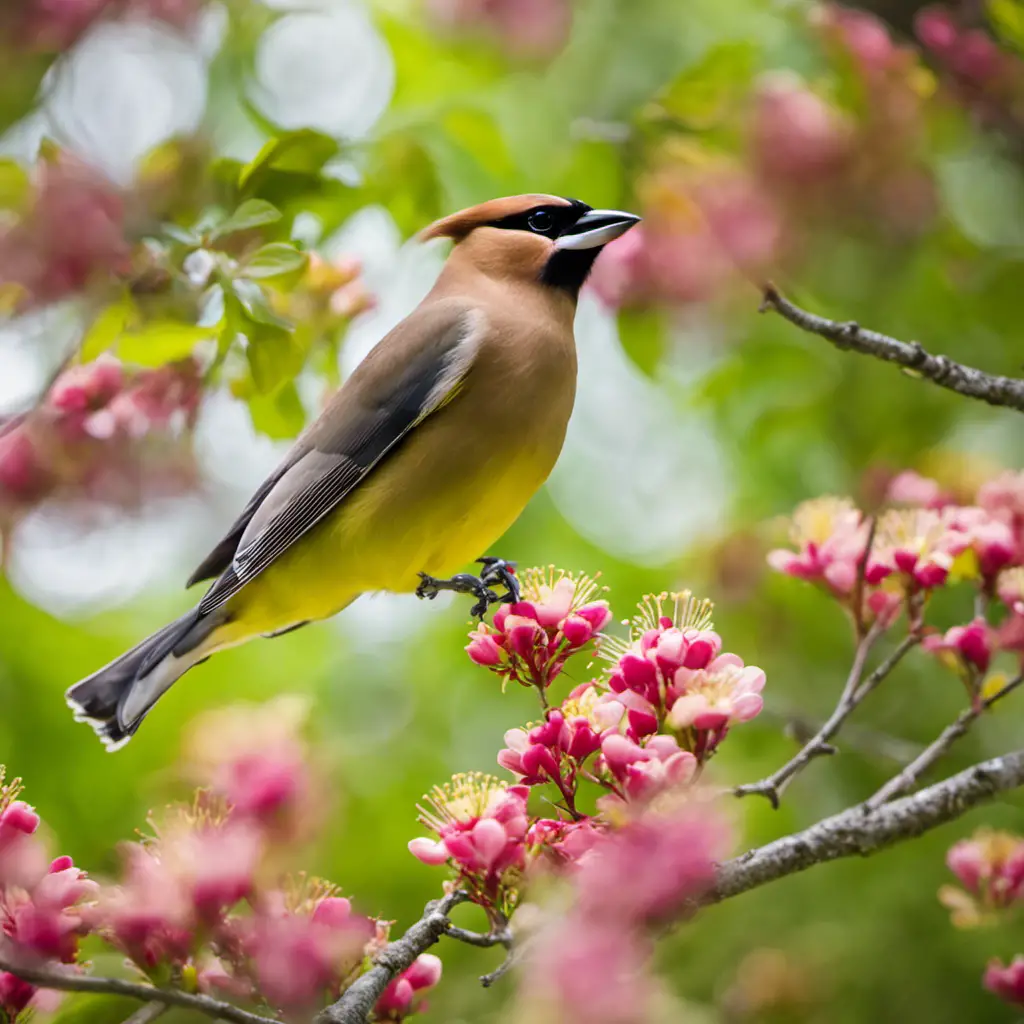
If you look closely, you can spot the common yellowthroat among the reeds and shrubs along the marshes and wetlands. These small, vibrant birds are known for their distinctive mask-like markings, making them easily recognizable.
Here are some interesting facts about the breeding habits and migration patterns of the common yellowthroat:
Breeding Habits: These birds are monogamous and form pair bonds during the breeding season. They build their nests low to the ground, hidden among the vegetation. The female takes on the majority of incubation duties while the male defends the territory.
Migration Patterns: Common yellowthroats are neotropical migrants, meaning they travel long distances between their breeding and wintering grounds. They breed throughout North America and then migrate to Central and South America for the winter. Their migration routes can vary, but many pass through the Caribbean.
These fascinating birds provide valuable insights into avian behavior and the importance of preserving their habitats for future generations to enjoy.
Yellow-throated Warbler
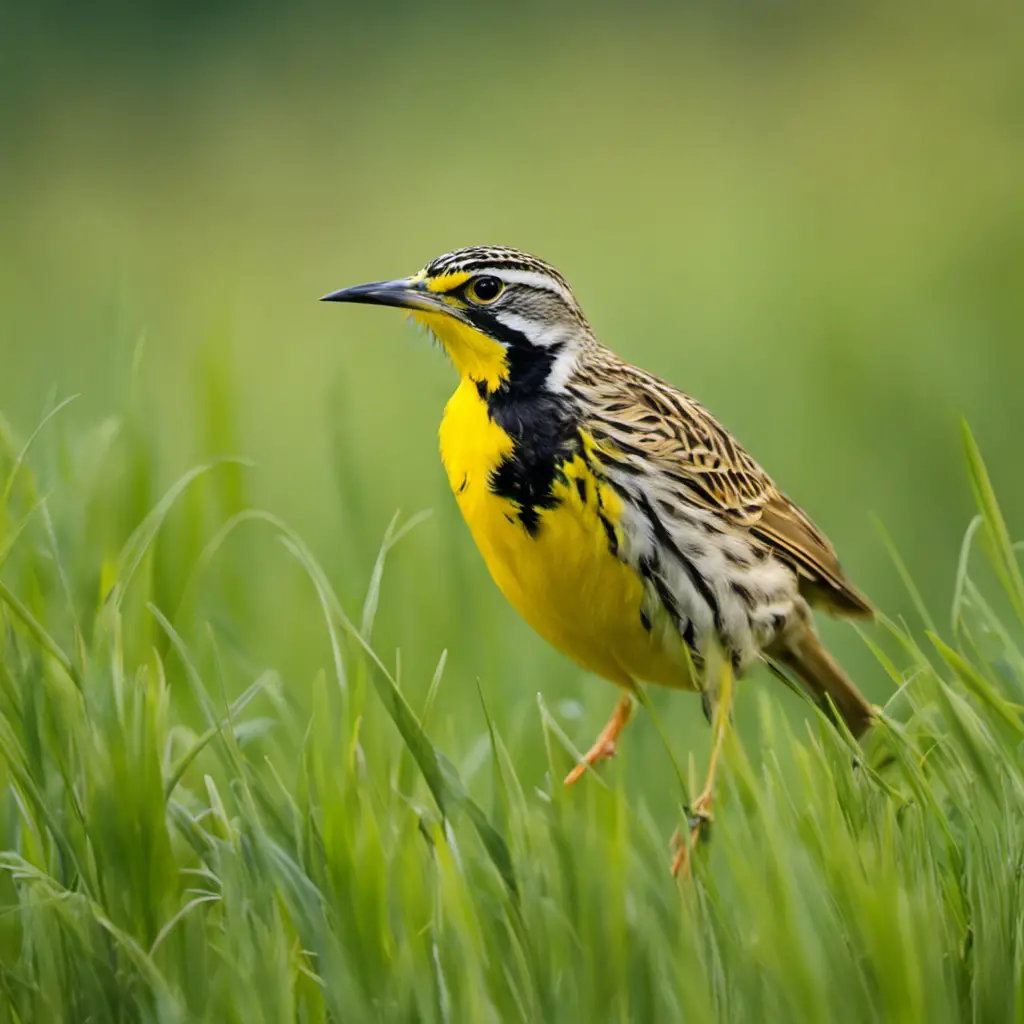
You can easily distinguish the yellow-throated warbler by its vibrant plumage and melodic song. This beautiful bird, scientifically known as Setophaga dominica, is a species of New World warbler. It is primarily found in the southeastern United States, including North Carolina, during the breeding season. However, during the winter months, the yellow-throated warbler migrates to Central America and the Caribbean.
To better understand the yellow-throated warbler’s habitat preferences and migration patterns, let’s take a look at the following table:
| Habitat Preferences | Migration Patterns |
|---|---|
| Deciduous forests | Winter migration |
| Riparian areas | Central America |
| Swamps | Caribbean |
From this table, we can see that the yellow-throated warbler favors deciduous forests, riparian areas, and swamps for its habitat. It is during the winter that these birds undertake their impressive migration to warmer regions, such as Central America and the Caribbean. Studying these patterns helps researchers and bird enthusiasts gain a deeper understanding of the yellow-throated warbler’s behavior and conservation needs.
Pine Warbler
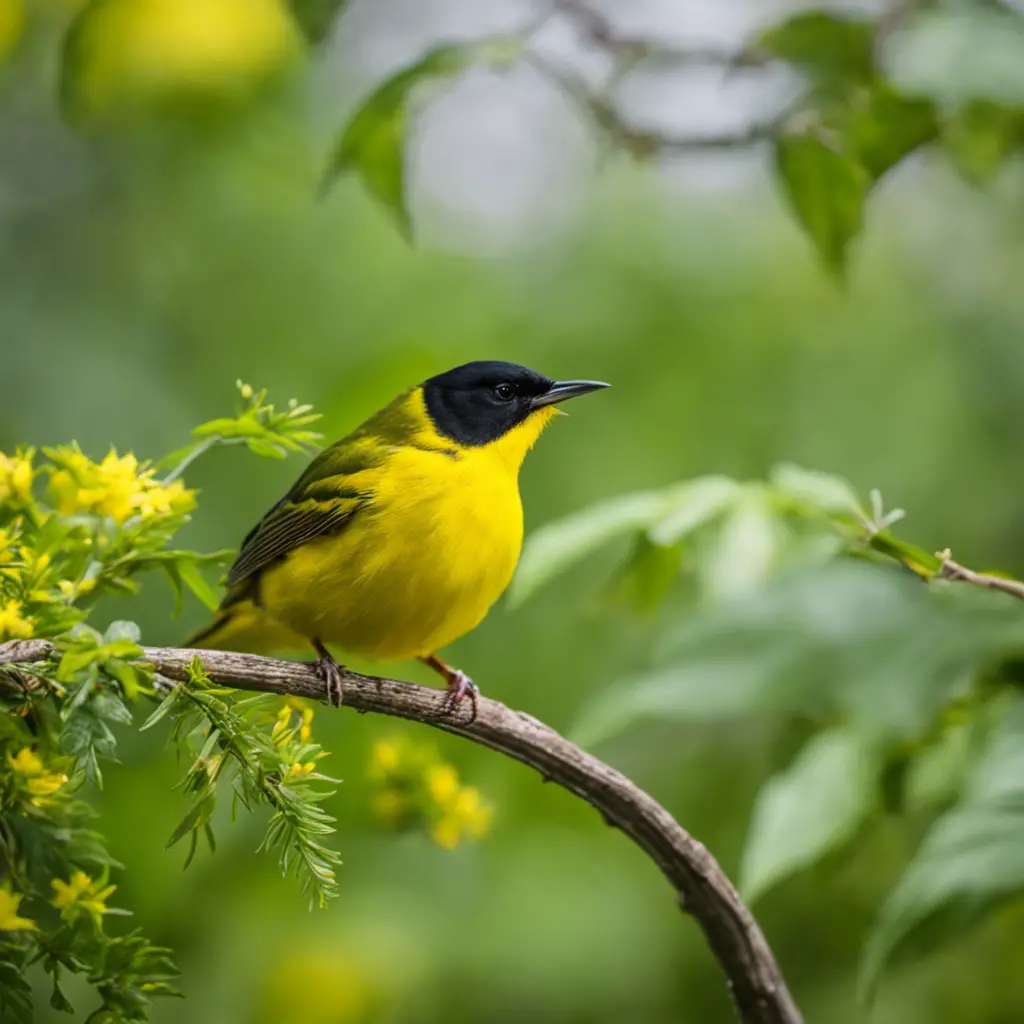
Take a closer look at the Pine Warbler, as its distinct song sets it apart from other yellow birds in North Carolina. This small songbird, measuring about 5.5 inches in length, is known for its vibrant yellow plumage and unique vocalizations.
Here are some intriguing facts about the Pine Warbler:
Pine Warblers are migratory birds, spending their summers in the coniferous forests of Canada and the northeastern United States before heading south for the winter.
They’ve a preference for pine forests, where they can find ample food and suitable nesting sites.
These birds are skilled foragers, often searching for insects and spiders among the pine needles and cones.
Pine Warblers are known to exhibit territorial behavior, defending their nesting sites from intruders.
Despite their preference for pines, they can also be found in mixed forests and even suburban areas with ample tree cover.
Understanding the migration patterns and habitat preferences of Pine Warblers is essential for their conservation and protection. By studying their behavior and habitat requirements, we can ensure a thriving population of these remarkable yellow birds in North Carolina.
Prothonotary Warbler
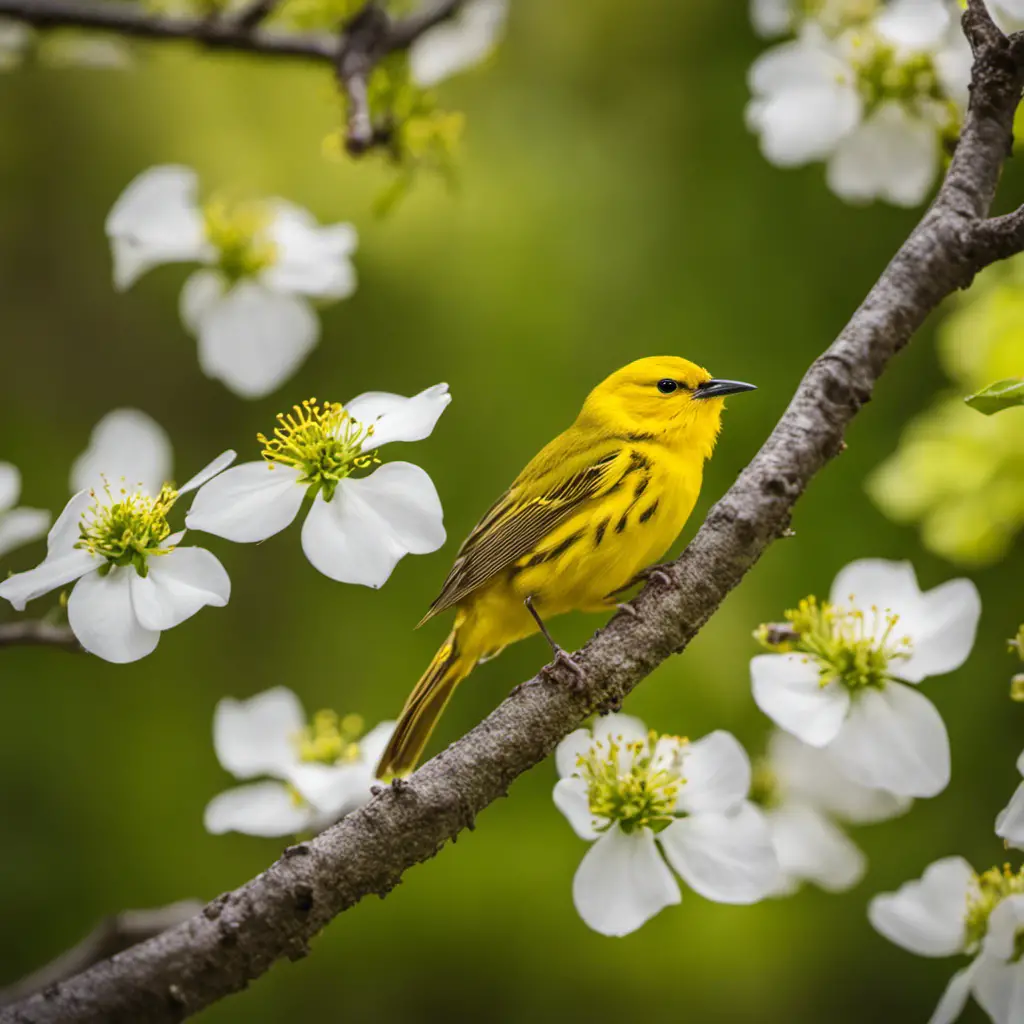
You’ll be amazed to learn that there are two species of yellow warblers in North Carolina, the Pine Warbler and the Prothonotary Warbler.
Today, we’ll focus on the Prothonotary Warbler, a stunning bird that can be found in the wetland areas of the state.
The Prothonotary Warbler is known for its vibrant yellow plumage and its preference for nesting in tree cavities near water.
To spot this elusive bird, it’s important to listen for its distinctive song, which sounds like a series of clear notes. Additionally, keeping an eye out for its low flight pattern and observing its habit of hopping along branches can greatly increase your chances of spotting one.
Hooded Warbler
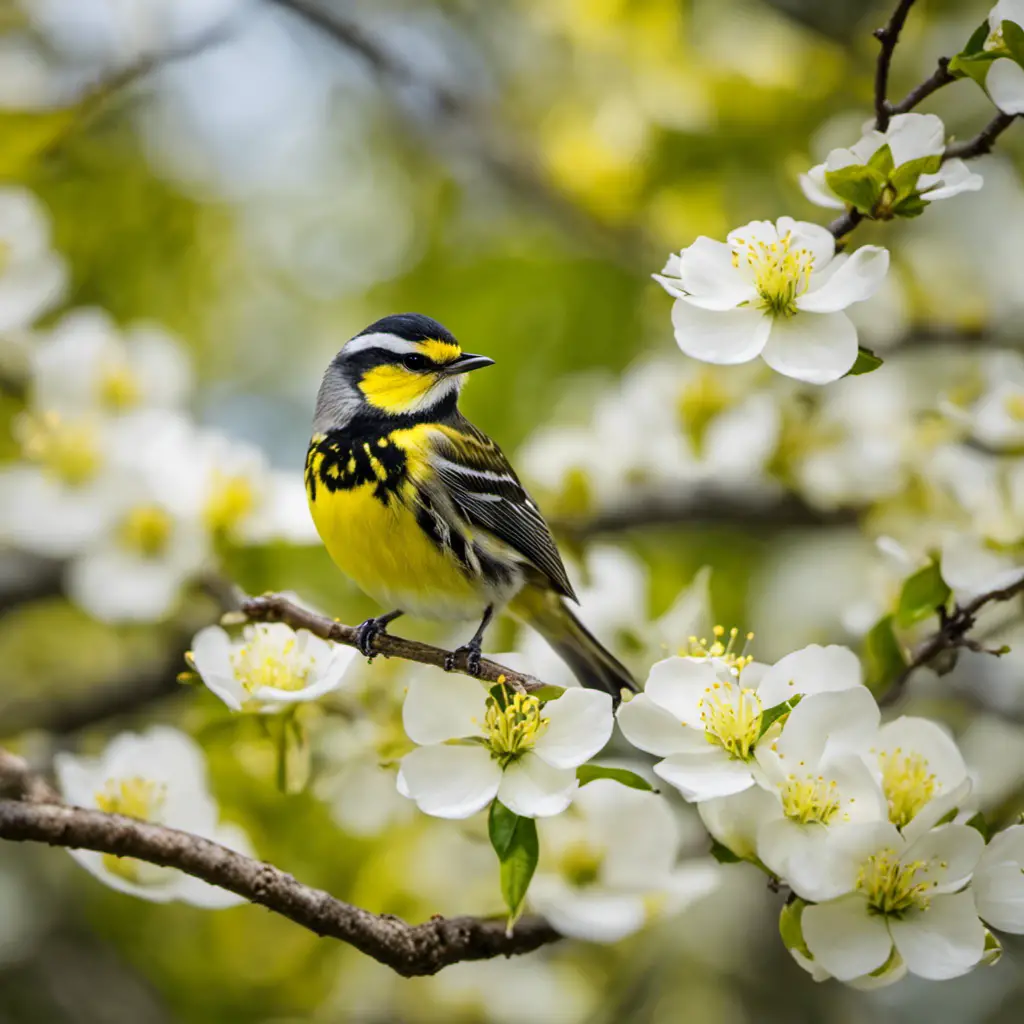
Spotting a Hooded Warbler can be challenging due to its small population size and preference for dense understory habitats. These small, brightly colored birds are known for their striking black hoods and vibrant yellow bodies.
Here are some interesting facts about Hooded Warblers:
Habitat preferences: Hooded Warblers are typically found in deciduous forests with dense understory vegetation, such as shrubs and young trees. They tend to avoid open areas and prefer habitats with thick vegetation for nesting and foraging.
Breeding behavior: Hooded Warblers are monogamous and form pair bonds during the breeding season. Males defend territories and attract females with their distinctive songs. The female builds a cup-shaped nest on or near the ground, usually hidden in vegetation.
Diet: These warblers primarily feed on insects, including caterpillars, beetles, and spiders. They forage actively in the understory, hopping and fluttering among leaves and branches to catch their prey.
Migration: Hooded Warblers are neotropical migrants, spending the winter in Central America and the Caribbean. They arrive in their breeding grounds in the eastern United States and parts of Canada during the spring.
Conservation status: The Hooded Warbler is currently listed as a species of least concern by the International Union for Conservation of Nature (IUCN). However, their population has been declining due to habitat loss, making their conservation an ongoing concern.
Understanding the habitat preferences and breeding behavior of the Hooded Warbler is crucial for their conservation. By preserving their preferred habitats and ensuring suitable nesting conditions, we can help maintain the population of these beautiful birds.
Kentucky Warbler

If you want to see a Kentucky Warbler, look for its distinctive black mask and bright yellow underparts in the dense understory of forests.
The Kentucky Warbler, scientifically known as Geothlypis formosa, is a small migratory bird that can be found in the eastern United States during the breeding season.
Its preferred habitat includes moist woodlands, especially those with a dense shrub layer and a rich leaf litter.
This warbler is known for its unique behavior of foraging on or near the ground, often hopping along fallen logs or scratching through the leaf litter in search of insects and spiders.
It also has a melodious song that consists of a series of rich, rolling notes.
The Kentucky Warbler is a secretive bird that prefers to stay hidden in the dense vegetation, making it a challenging species to observe.
However, with patience and careful observation, you may be rewarded with a glimpse of this beautiful bird in its natural habitat.
Worm-eating Warbler
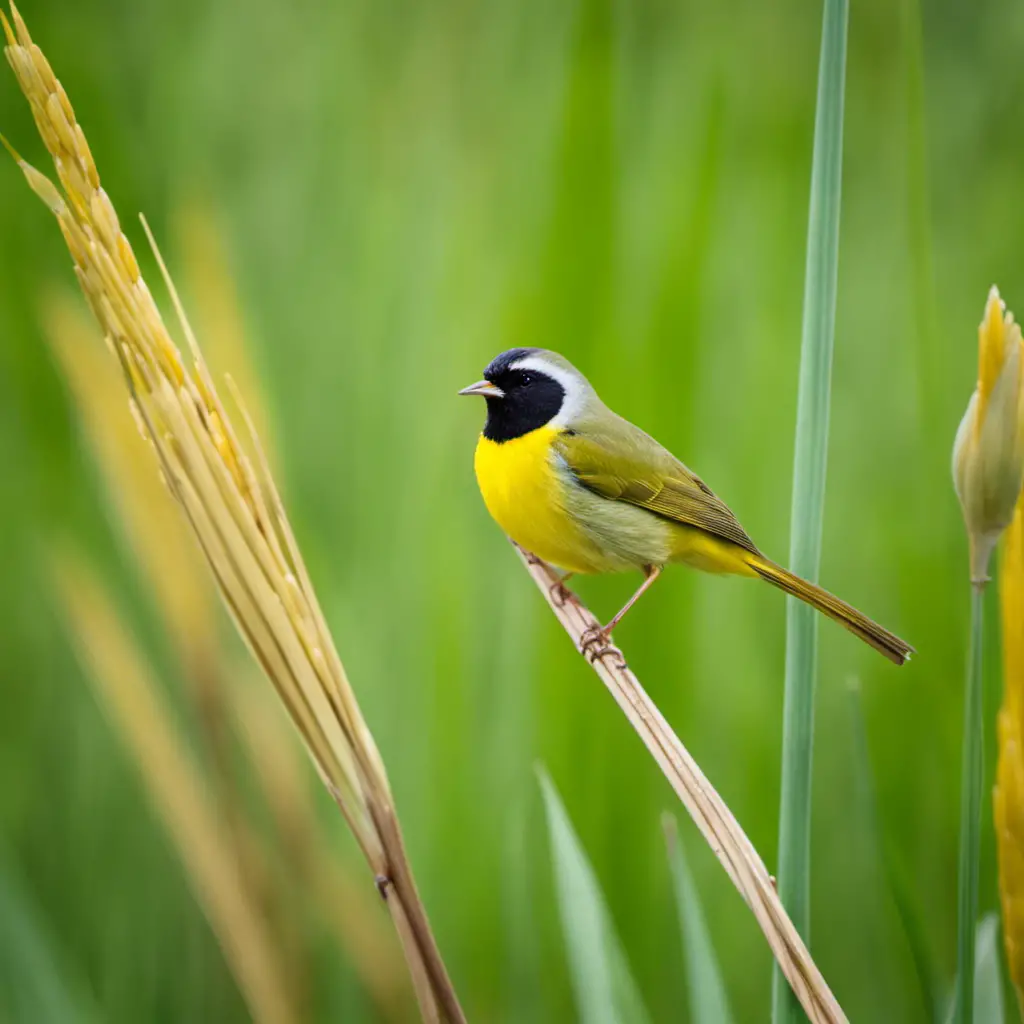
You can easily identify the Worm-eating Warbler by its distinctive black and white striped head and its preference for foraging for insects among the leaf litter on the forest floor. This small songbird is native to the eastern United States and can be found in deciduous forests, particularly in the southeastern states. Here are some interesting facts about the Worm-eating Warbler:
Migration patterns: The Worm-eating Warbler is a Neotropical migrant, which means it travels long distances between its breeding grounds in the eastern United States and its wintering grounds in Central and South America.
Breeding habits: These birds are monogamous and form pair bonds during the breeding season. They build cup-shaped nests on the ground, often hidden among the undergrowth.
Diet: As their name suggests, Worm-eating Warblers primarily feed on insects, particularly caterpillars and spiders. They use their sharp beaks to probe the leaf litter in search of their prey.
Plumage: Apart from their distinctive head pattern, male Worm-eating Warblers have a light brown back and wings, while females have a slightly duller appearance.
Conservation status: The Worm-eating Warbler is currently listed as a species of least concern, but its populations may be declining due to habitat loss and fragmentation.
Understanding the migration patterns and breeding habits of the Worm-eating Warbler allows us to appreciate their unique role in the ecosystem and highlights the importance of preserving their forest habitats.
Prairie Warbler
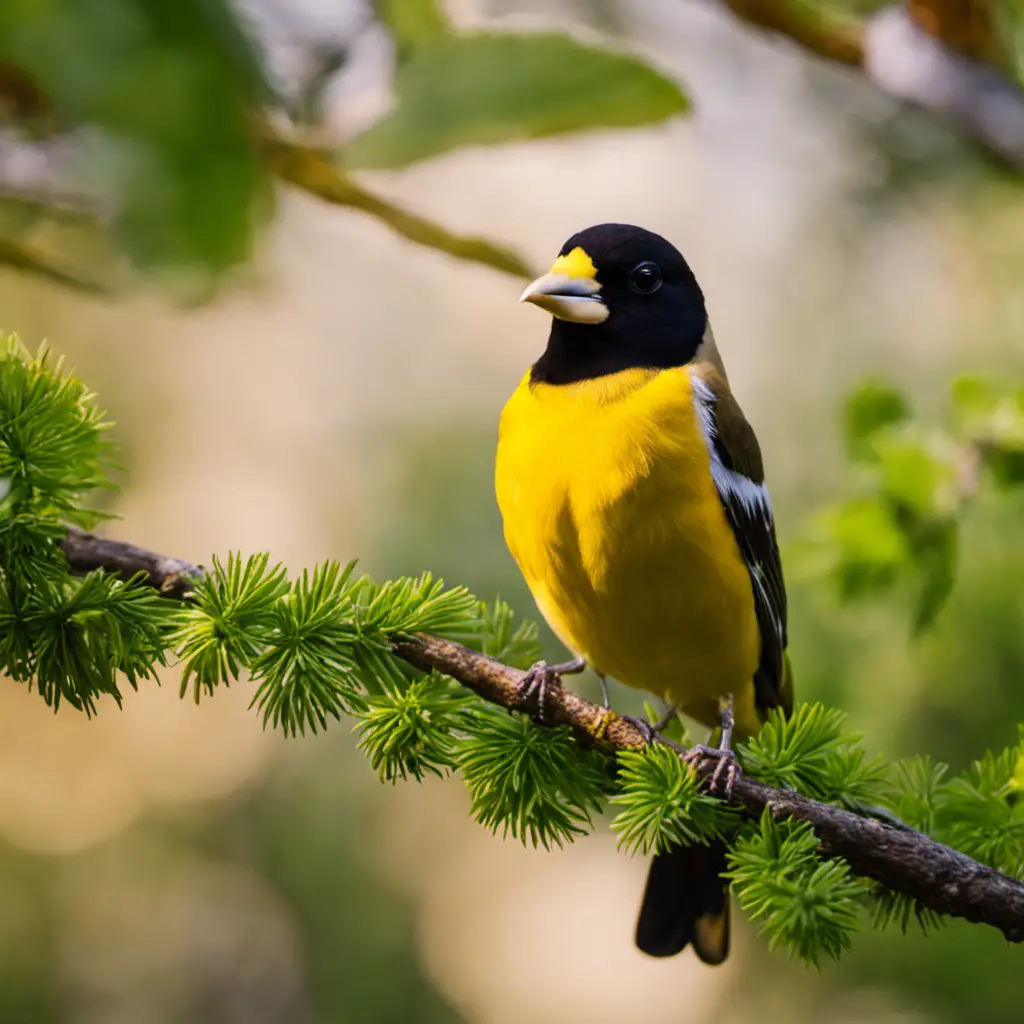
When birdwatching in North Carolina, keep an eye out for the Prairie Warbler, as it can be easily identified by its bright yellow plumage and distinctive black streaks. This small songbird is a common summer resident in the eastern United States and can be found in a variety of habitats, including shrubby fields, young forests, and open woodlands.
The Prairie Warbler prefers areas with dense understory vegetation, where it can forage for insects and spiders. It’s known for its unique behavior of frequently flicking its tail and hopping among branches in search of food.
During breeding season, the male Prairie Warbler sings a high-pitched and continuous song to attract a mate and defend its territory. It constructs a cup-shaped nest in a shrub or low tree, where the female lays her eggs.
Observing the Prairie Warbler in its natural habitat can provide valuable insights into its behavior and ecology.
Black-throated Green Warbler

Keep an eye out for the Black-throated Green Warbler, as it sings a high-pitched song and hops among branches while foraging for insects. This small, vibrant bird is known for its striking black throat and bright yellow plumage.
Here are some fascinating facts about the Black-throated Green Warbler:
Migration Patterns: The Black-throated Green Warbler is a long-distance migratory bird, traveling from its breeding grounds in North America to wintering areas in the Caribbean and Central America.
Habitat Preferences: These warblers typically breed in mature coniferous or mixed forests, where they build their nests in the upper branches. During migration and winter, they can be found in a variety of habitats, including deciduous forests and tropical rainforests.
Feeding Behavior: Black-throated Green Warblers primarily feed on insects, such as caterpillars, beetles, and spiders. They’re often seen gleaning insects from leaves and branches, or hovering to catch insects in mid-air.
Breeding Habits: Males engage in intricate courtship displays, singing their melodic songs from high perches to attract females. Once paired, the female builds a cup-shaped nest using twigs, grass, and moss.
Conservation Status: While the Black-throated Green Warbler is currently listed as a species of least concern, habitat loss and climate change pose threats to their populations, emphasizing the importance of preserving their breeding and wintering habitats.
Observe the Black-throated Green Warbler’s beautiful plumage and behavior as it journeys through its migratory path, and appreciate the delicate balance required to protect its preferred habitats.
Blackburnian Warbler

Take a moment to observe the vibrant colors of the Blackburnian Warbler, as it migrates through North Carolina. This small songbird, named after Anna Blackburne, is known for its striking orange throat and black and white plumage.
The Blackburnian Warbler is a neotropical migrant, breeding in the boreal forests of Canada and the northeastern United States, before embarking on its long journey to Central and South America for the winter. Its migration patterns have been well-studied, with researchers using geolocators to track their movements. These tiny birds navigate using a combination of celestial cues and magnetic fields, allowing them to find their way across vast distances.
During the breeding season, the Blackburnian Warbler constructs cup-shaped nests high up in the trees, typically in coniferous forests. The female lays 3-5 eggs, which she incubates for about 12 days. Once hatched, both parents share the responsibility of feeding their young until they’re ready to fledge.
Understanding the migration patterns and breeding habits of the Blackburnian Warbler is crucial for its conservation, as it faces threats from habitat loss and climate change. By studying these birds, scientists can develop effective conservation strategies to ensure their survival for future generations.
Chestnut-sided Warbler

You often spot the Chestnut-sided Warbler during the spring and summer months in North Carolina. These small, colorful birds are known for their vibrant plumage and distinctive chestnut-colored flanks. Here are five interesting facts about Chestnut-sided Warblers:
The Chestnut-sided Warbler is a Neotropical migrant, meaning it travels long distances between its breeding grounds in North America and its wintering grounds in Central and South America.
During migration, these birds navigate using a combination of celestial cues, landmarks, and magnetic fields.
Conservation efforts for Chestnut-sided Warblers focus on preserving their breeding and wintering habitats, as well as creating stopover sites along their migration routes.
These birds prefer early successional forests and shrubby habitats for breeding, but they also utilize a variety of forest types during migration and winter.
Climate change poses a significant threat to Chestnut-sided Warblers, as it alters the timing of their migration and affects the availability of food resources along their route.
Understanding the migration patterns and implementing effective conservation strategies are crucial for ensuring the continued presence of these beautiful birds in North Carolina and beyond.
Yellow-breasted Chat
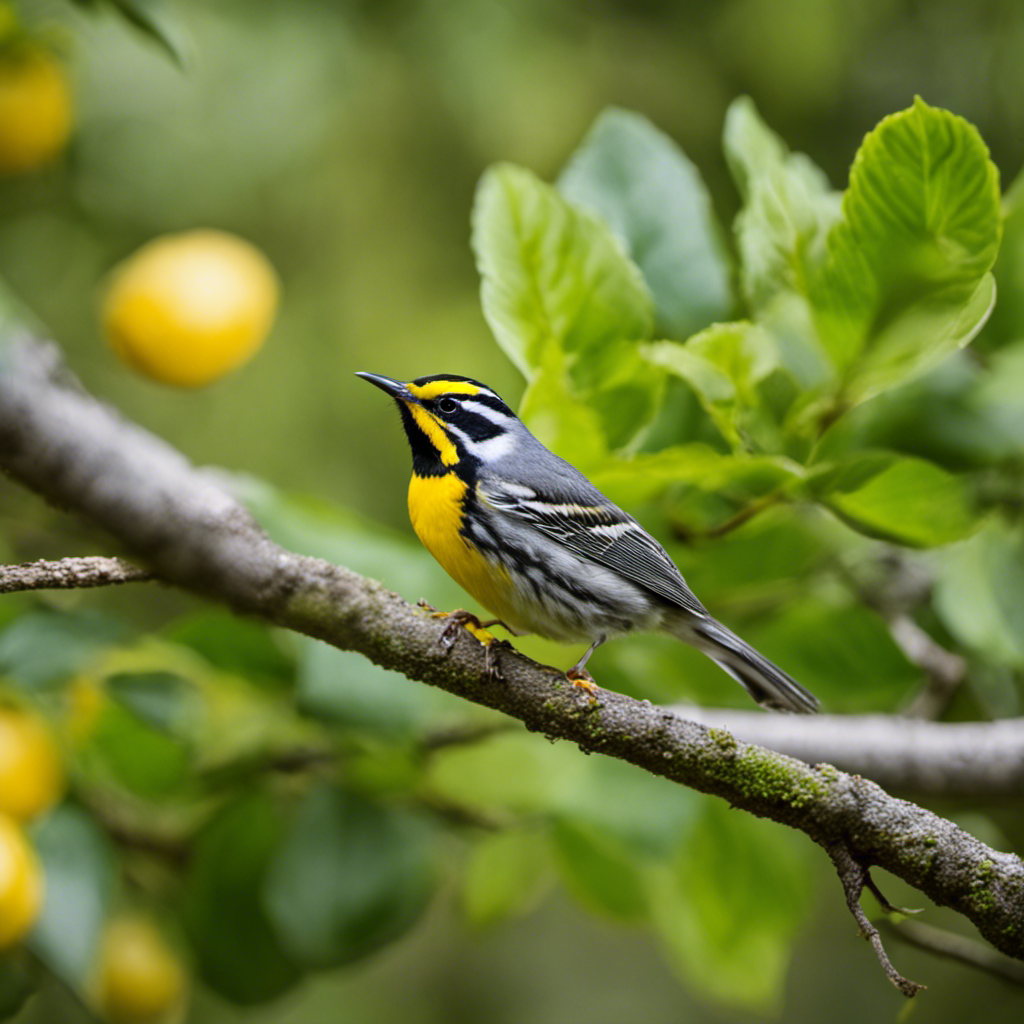
Don’t overlook the Yellow-breasted Chat, for it’s a vibrant and melodious bird found in North Carolina.
The Yellow-breasted Chat, scientifically known as Icteria virens, is a medium-sized songbird that can be easily identified by its bright yellow breast and distinctive song.
This species is primarily found in dense thickets and shrubby habitats, such as woodland edges, abandoned fields, and overgrown clearings. It prefers areas with ample vegetation for nesting and foraging.
The diet of the Yellow-breasted Chat consists mainly of insects, including grasshoppers, beetles, and caterpillars. Additionally, it also consumes fruits and berries, especially during the fall migration period.
This bird’s unique combination of bright colors and melodic song make it a delightful addition to North Carolina’s avian diversity.
Orchard Oriole
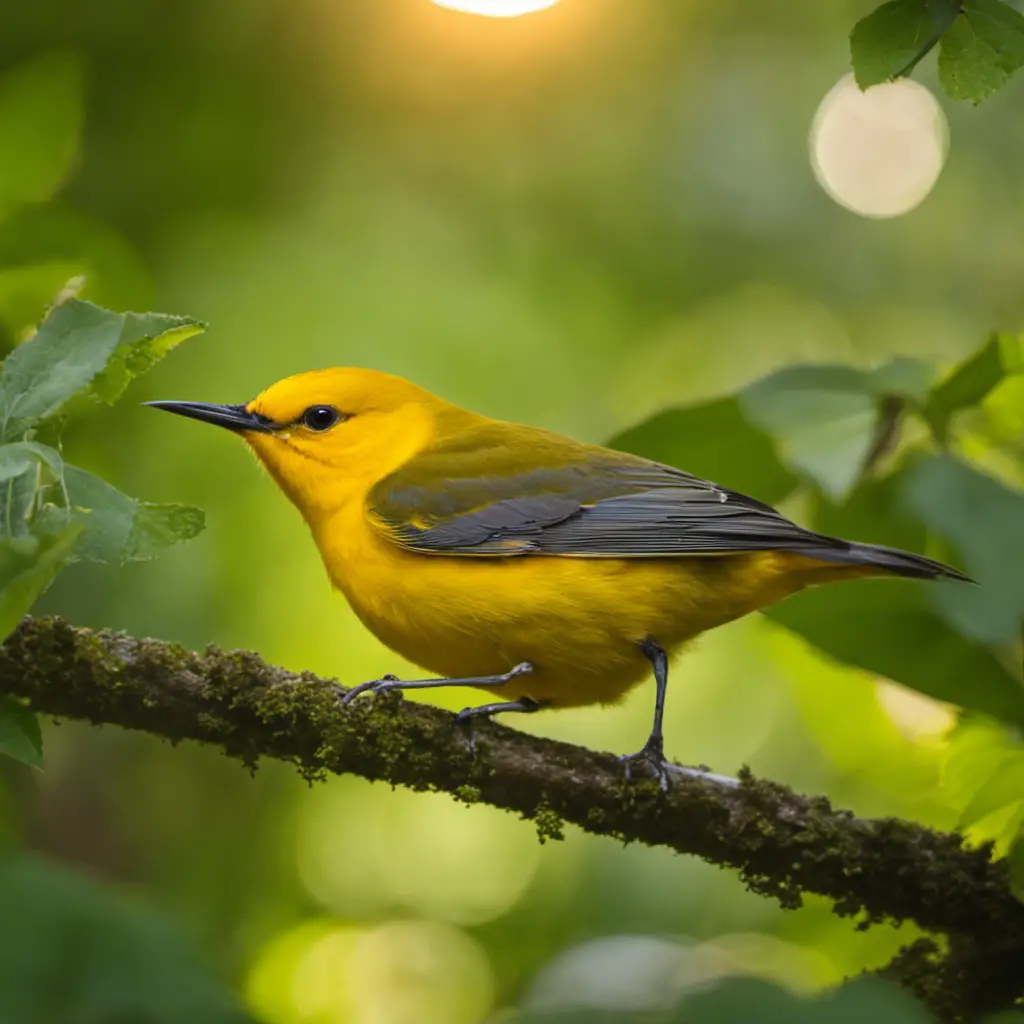
If you look closely, you’ll notice that the Orchard Oriole has a vibrant orange coloration, making it stand out among other birds in North Carolina. This small songbird, measuring around 6.5 inches in length, is a common summer resident in the eastern parts of the state.
Here are some interesting facts about the Orchard Oriole:
- The males have a distinct black hood and back, contrasting with their orange underparts.
- Females have a more subdued coloration, with olive-green upperparts and yellowish underparts.
- Orchard Orioles primarily feed on insects, nectar, and fruits, making them important pollinators and seed dispersers.
- During migration, these orioles travel long distances, wintering in Central America and the northern regions of South America.
- They’re known to breed in open woodlands, orchards, and even suburban areas, where they build intricate basket-shaped nests.
Understanding the migration patterns and behavior of birds like the Orchard Oriole allows researchers to gain insight into the ecological connections between different habitats and regions. By studying these patterns, scientists can better understand how changes in the environment impact bird populations and their ecosystems.
Baltimore Oriole
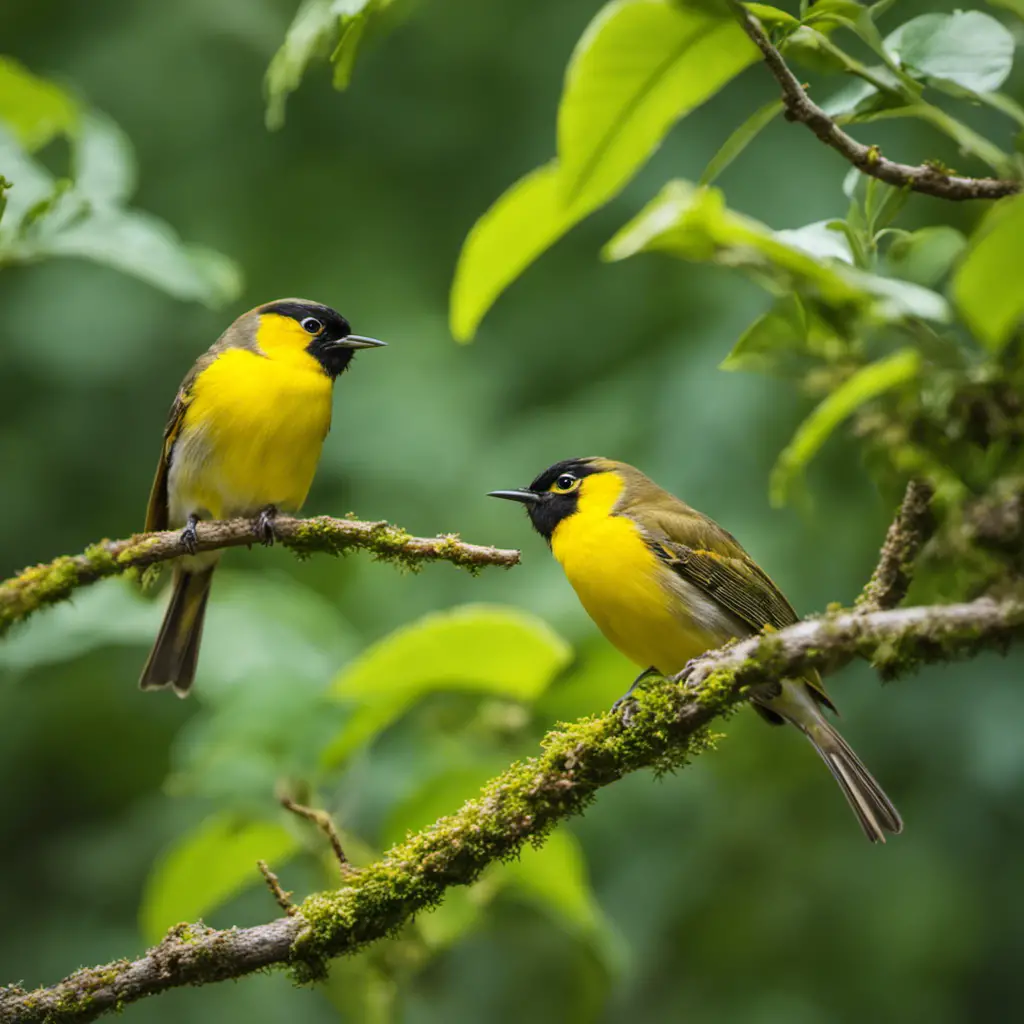
Spotting a bright orange Baltimore Oriole in your backyard can be a delightful sight during the spring migration. These migratory birds are known for their vibrant plumage, with the males displaying a striking orange coloration while the females have a more subdued yellowish hue.
Baltimore orioles are primarily insectivores, feeding on a variety of insects such as caterpillars, beetles, and spiders. However, they also consume nectar from flowers and enjoy fruits such as oranges and berries.
During their migration, Baltimore orioles travel long distances, often crossing the Gulf of Mexico to reach their breeding grounds in North America. It’s important to provide food sources like oranges and jelly feeders to attract these beautiful birds during their migration and support their diet.
Eastern Meadowlark
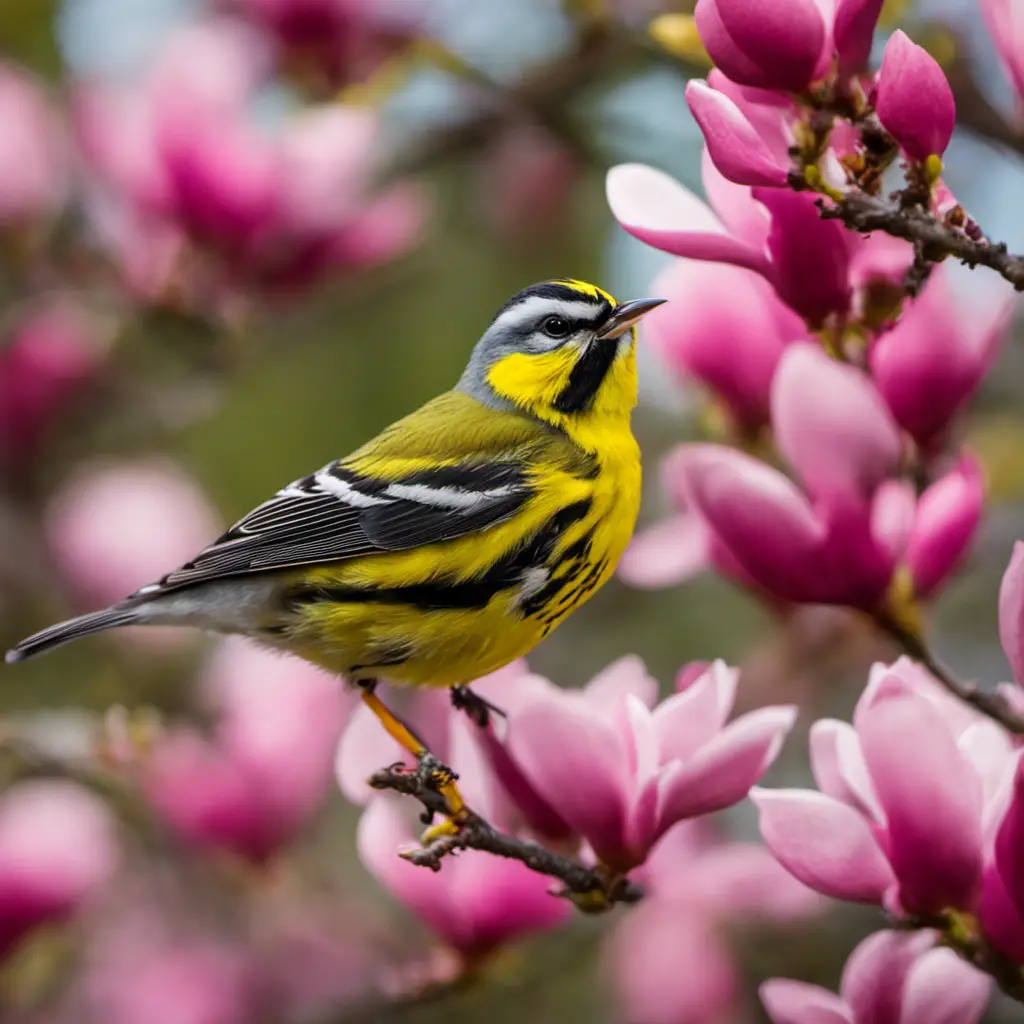
You’ll appreciate the distinctive melodic song of the Eastern Meadowlark as it fills the air with its enchanting melody. This beautiful bird, known for its vibrant yellow plumage and black V-shaped chest pattern, is a delight to both the eyes and ears.
Here are five fascinating facts about the Eastern Meadowlark:
Bird songs: The Eastern Meadowlark is known for its melodious and flute-like song, consisting of a series of clear, whistling notes. Its song is often described as a sweet, flute-like whistle or a clear, whistled ‘see-you-see-yoo’.
Habitat preferences: These birds prefer open grasslands, meadows, and pastures where they can forage for insects and seeds. They’re often found in agricultural fields, roadside ditches, and golf courses.
Breeding behavior: Eastern Meadowlarks are monogamous birds and form pairs during the breeding season. They build their nests on the ground, hidden among vegetation, and the female lays 3-6 eggs.
Migration patterns: While some Eastern Meadowlarks are year-round residents in the southern parts of their range, many migrate to the southern United States, Mexico, and Central America during the winter months.
Conservation status: The Eastern Meadowlark is considered a species of least concern by the International Union for Conservation of Nature (IUCN). However, loss of suitable grassland habitats due to agriculture and urbanization poses a threat to their populations.
Observing and listening to the Eastern Meadowlark in its natural habitat is a memorable experience for any bird enthusiast.
Common Yellowthroat
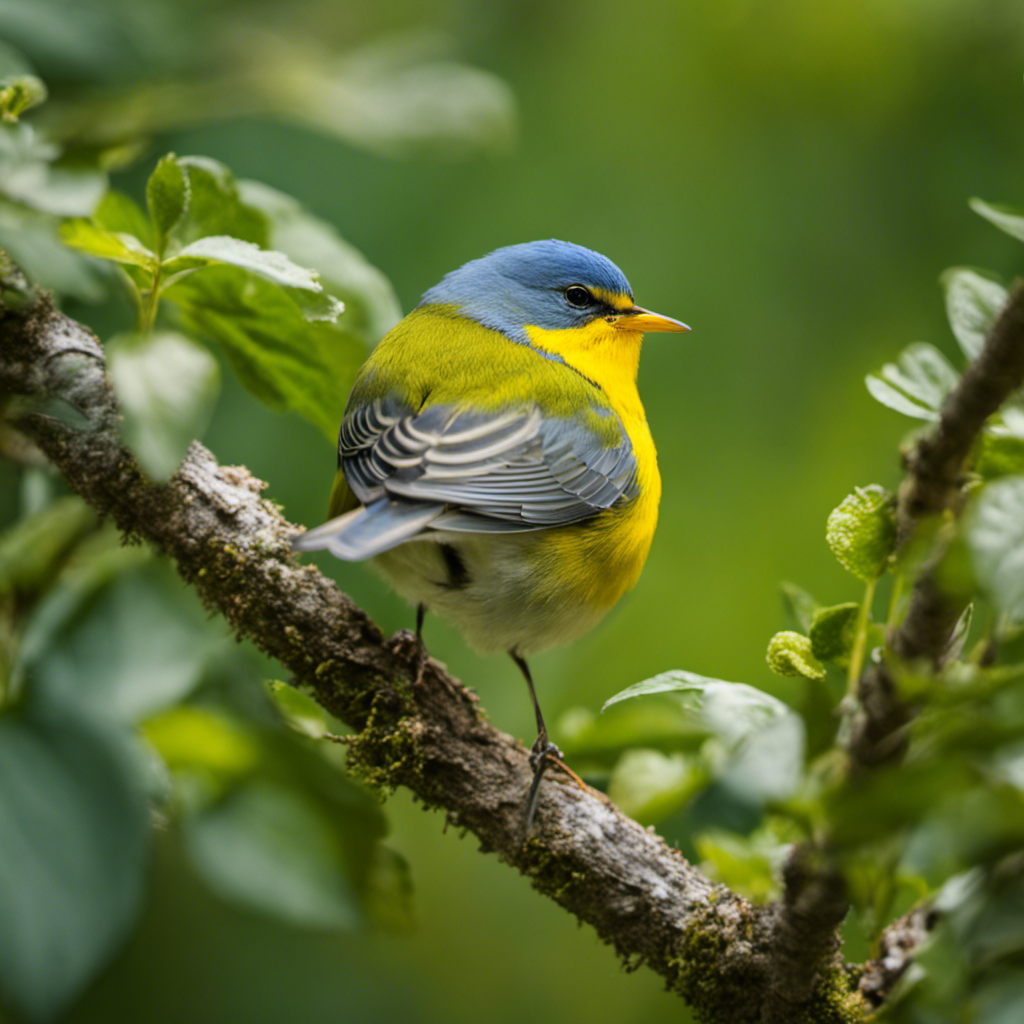
You can easily identify the Common Yellowthroat by its distinctive black mask and bright yellow feathers. This small songbird is a common sight across North America, including North Carolina.
The Common Yellowthroat is known for its unique migration patterns and breeding habits. During the spring and summer, these birds can be found in wetlands, marshes, and thickets, where they build their nests in low shrubs or on the ground.
The male Common Yellowthroat is known for its loud, repetitive song, which it uses to attract a mate and defend its territory. In the fall, these birds migrate south to warmer regions, such as Central and South America, where they spend the winter months.
Understanding the migration patterns and breeding habits of the Common Yellowthroat is crucial for conservation efforts and ensuring the survival of this beautiful bird species.
Yellow-billed Cuckoo
If you listen carefully, you can hear the distinct call of the elusive Yellow-billed Cuckoo echoing through the forest. This unique bird, known for its striking yellow bill and long tail, is a fascinating species to study.
Here are some intriguing facts about the Yellow-billed Cuckoo:
Migration patterns: The Yellow-billed Cuckoo is a neotropical migrant, spending its winters in South America and migrating to North America for the breeding season.
Nesting behavior: These birds are known for their secretive nesting habits. They build their nests in dense vegetation, often near water sources, using twigs, leaves, and grasses.
Incubation period: The female Yellow-billed Cuckoo is responsible for incubating the eggs, which typically takes around 11-12 days. The male assists in feeding the female during this time.
Diet: The Yellow-billed Cuckoo primarily feeds on insects, especially caterpillars, which are abundant during the breeding season.
Conservation status: Due to habitat loss and degradation, the Yellow-billed Cuckoo’s population has declined in recent years, leading to its classification as a threatened species.
Understanding the Yellow-billed Cuckoo’s migration patterns and nesting behavior is crucial for its conservation and protection. By studying these remarkable birds, we can contribute to their preservation and ensure their continued presence in our forests.
Yellow-crowned Night-Heron
Take a moment to observe the graceful movements of the Yellow-crowned Night-Heron as it hunts for its prey along the water’s edge. This elegant bird, scientifically known as Nyctanassa violacea, is a sight to behold. With its distinct yellow crown and beautiful plumage, the Yellow-crowned Night-Heron stands out among its avian counterparts. Conservation efforts for this species have been implemented to protect its habitat and ensure its survival. The Yellow-crowned Night-Heron is known to migrate, with patterns varying depending on its geographical location. Some populations migrate to the Caribbean, while others migrate along the coast of the southeastern United States. These migrations are fascinating to observe and are essential for the bird’s survival. By understanding the migration patterns and implementing conservation measures, we can help preserve the Yellow-crowned Night-Heron for future generations to admire.
| Yellow-crowned Night-Heron | Description |
|---|---|
| Scientific Name | Nyctanassa violacea |
| Conservation Status | Least Concern |
| Habitat | Wetlands, marshes, and coastal areas |
| Migration Patterns | Varies depending on geographical location |
| Key Conservation Efforts | Protecting habitats, reducing pollution, and promoting awareness |
Yellow-bellied Sapsucker
Notice how the Yellow-bellied Sapsucker uses its beak to create distinct patterns of holes in trees for sap to seep out, attracting insects for it to feast on. This unique behavior is just one of the fascinating aspects of the yellow-bellied sapsucker’s habitat, behaviors, and feeding habits.
Here are some discussion ideas to delve deeper into this topic:
Habitat: The yellow-bellied sapsucker can be found in North America, specifically in deciduous forests and mixed woodlands.
Feeding Habits: This bird primarily feeds on sap, drilling holes in trees to access this nutritious resource. It also consumes insects attracted to the sap.
Behavior: The yellow-bellied sapsucker is known for its drumming behavior, creating distinctive patterns of holes called ‘sap wells’ for both feeding and territorial purposes.
Migration: This bird is a long-distance migrant, traveling to its breeding grounds in the northern parts of North America and migrating south for the winter.
Conservation: The yellow-bellied sapsucker faces threats such as habitat loss and climate change, making it important to understand its behaviors and protect its habitat.
Yellow-throated Vireo
You often hear the sweet songs of the Yellow-throated Vireo in the North Carolina forests, and it’s a beautiful sight to behold. These small, migratory birds are known for their striking yellow throats, contrasting with their olive-green bodies.
Understanding their migration patterns and nesting behavior can provide valuable insight into their lives. Yellow-throated Vireos are neotropical migrants, spending their summers in North America and winters in Central and South America. They embark on their long journey twice a year, navigating thousands of miles to find suitable breeding and feeding grounds.
During the nesting season, these vireos construct cup-shaped nests made of twigs, bark strips, and plant fibers, typically placed on a horizontal branch high in the forest canopy. The female lays a clutch of 3-4 eggs, which both parents take turns incubating. Once hatched, the parents work together to feed and care for their young until they’re ready to fledge.
Observing their migration patterns and nesting behavior provides valuable information for conservation efforts and helps us appreciate the wonders of nature.
Yellow-green Vireo
You can spot the Yellow-green Vireo in the trees, among the leaves, and on the branches, for it’s known to frequent dense foliage and sing with a distinct melodic tone. This species, scientifically known as Vireo flavoviridis, is a small passerine bird found in parts of Central and South America.
Here are some fascinating facts about the Yellow-green Vireo:
Habitat: These birds inhabit tropical and subtropical forests, particularly those with dense vegetation and a variety of tree species.
Behavior: Yellow-green Vireos are active and agile, often seen foraging for insects and small fruits in the upper canopy. They’ve a unique habit of flicking their wings while perched.
Breeding: This species builds cup-shaped nests made of vegetation and spider silk, usually placed in the forks of tree branches.
Vocalizations: Their song is a series of clear, high-pitched notes, delivered with a rising and falling cadence.
Conservation: Due to habitat loss caused by deforestation, the Yellow-green Vireo is facing population declines. Conservation efforts focus on protecting and restoring their forest habitats, as well as raising awareness about their importance as indicators of ecosystem health.
Yellow-headed Blackbird
If you look closely, you’ll notice the Yellow-headed Blackbird’s distinctive yellow head and black body. These birds are known for their striking appearance and unique characteristics. The Yellow-headed Blackbird is a migratory species, with distinct migration patterns that vary depending on the region. In the spring and summer, they can be found in wetland areas across North America, including marshes, ponds, and reed beds. During the winter, they migrate to southern regions with milder climates.
The habitat preferences for Yellow-headed Blackbirds are closely tied to their need for wetland areas. They prefer nesting in marshes and wet meadows, where they can find suitable food sources, such as insects, seeds, and aquatic plants. These birds also require open areas for feeding and displaying their distinctive yellow heads to potential mates. Protecting and preserving wetland habitats is crucial for the survival of these beautiful birds and the maintenance of their populations.
| Migration Patterns | Habitat Preferences |
|---|---|
| Spring and summer | Wetland areas |
| Winter | Southern regions |
| Marshes and wet meadows | |
| Open areas |
Frequently Asked Questions
What Is the Habitat Preference of the Yellow Warbler?
The yellow warbler, a migratory bird, is known for its habitat preference during nesting season. It tends to select areas with dense shrubs and trees near water sources. Understanding its nesting habits and migration patterns is crucial for conservation efforts.
How Can You Distinguish Between the Yellow-Rumped Warbler and the Pine Warbler?
To distinguish between the yellow-rumped warbler and the pine warbler, observe their different plumage patterns, listen for their distinct bird songs and calls. These characteristics can help you identify each species accurately.
Are There Any Specific Behaviors or Characteristics That Are Unique to the Prothonotary Warbler?
The prothonotary warbler has unique behaviors and characteristics, as well as specific breeding habits and nesting preferences. Understanding these traits can provide insights into the species’ behavior and ecology.
What Is the Diet of the Hooded Warbler?
The hooded warbler’s diet consists mainly of insects and fruits. This species consumes a wide variety of insects, including beetles and caterpillars, and also feeds on fruits such as berries and small fruits.
Where Is the Primary Breeding Range of the Blackburnian Warbler?
The primary breeding range of the Blackburnian warbler is in northeastern North America, from the boreal forests of Canada down to the Appalachian Mountains. It prefers coniferous and mixed forests with tall trees for nesting.
Conclusion
In conclusion, North Carolina is home to a vibrant array of yellow birds. From the American Goldfinch and Yellow Warbler to the Yellow-rumped Warbler and Common Yellowthroat, these avian species bring a splash of color to the state’s landscapes.
Additionally, the Yellow-throated Warbler, Yellow-bellied Sapsucker, Yellow-throated Vireo, Yellow-green Vireo, and Yellow-headed Blackbird further contribute to the diversity of yellow birds found in North Carolina.
Their presence adds to the rich tapestry of wildlife in the region, making it a true haven for bird enthusiasts and nature lovers alike.

An avid ornithologist, zoologist and biologist with an unwavering passion for birds and wild animals.
Dr. Wilson’s journey in ornithology began in childhood and led him to obtain a Ph.D. in Ornithology from the prestigious Avian Research Institute. He has worked closely with renowned experts in the field and conducted extensive research and field studies globally.

